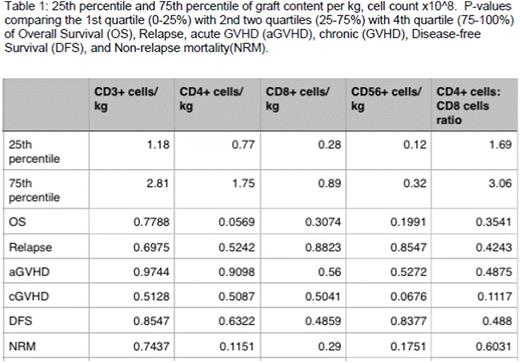Abstract
Background: The best results for allogeneic hematopoietic cell transplants (HCT) remain with HLA-matched sibling donors. Unfortunately, these donors are only available to about 30% of patients. Alternative donors have been used to fill this gap. Since the introduction of graft-versus-host disease (GVHD) prophylaxis with post-transplant cyclophosphamide (PTCy),haploidentical (haplo) donors have emerged as a resource with near universal availability. This type of transplant hasthe potential for greater graft-versus-leukemia effect, but increased bi-directionalalloreactivity. Identification of modifiable variables inhaplo-HCT that will optimize overall survival and predict relapse is importantin improving patient outcomes after transplant.
Objectives: To characterize the impact of graft lymphocyte content in haploidentical hematopoietic cell transplants (haplo-HCT) from peripheral-blood stem cell (PBSC) source using PTCy.
Methods: We retrospectively identified all patients undergoing haplo-HCT at our institution between June 2009 and October 2016. We assessed the impact of CD3 content, CD4 content, CD8 content, CD4:CD8 ratio, and CD56 content of the graft on post transplant outcomes. Statistical evaluation was done based on grouping of separate quartiles for each variable; this was compiled into 3 groupings based on the quartiles: quartile 1, quartile 2 & 3, and quartile 4. Acute and chronic GVHD were graded based on established criteria. Overall survival (OS) was calculated using log-rank test of equality. Overall survival (OS), relapse, acute GVHD, chronic GVHD, disease-free survival (DFS), and non-relapse mortality (NRM) were defined as time from transplantation to the event.
Results: We identified 127 patients undergoing haplo-HCT between June 2009 and October 2016. CD4 content, CD8 content, CD4:CD8 ratio, CD3 content and CD56 content of the graft was assessed using clinical flow cytometry. The values defining each group for analysis are shown in table 1. For CD4:CD8 ratio, no significant difference was seen in log-rank test of equality between the 3 groupings in regards to overall survival (chi-square 2.0761, 2 degrees of freedom, P=0.3541). No significant difference was seen for cumulative incidence of relapse, acute GVHD, DFS, and NRM. For CD4:CD8 ratio, chronic GVHD did approach significance (p=0.1117), but the number of patients that fit this criteria was quite low (n=37). For all other cell content assessments (CD4, CD8, CD3, CD56) of the graft, there was no significant findings in regards to OS, relapse, NRM, DFS, acute GVHD, and chronic GVHD.
Conclusions: Graft lymphocyte content inhaplo-HCT does not significantly impact survival, relapse, or GVHD. CD4/CD8 ratio content does approach significance with chronic GVHD, but this will need further evaluation. Other variables must be sought to optimize and improvehaploidentical transplants, as they are nearly universally available donor resources.
Schroeder:Incyte Corporation: Honoraria, Research Funding.
Author notes
Asterisk with author names denotes non-ASH members.


